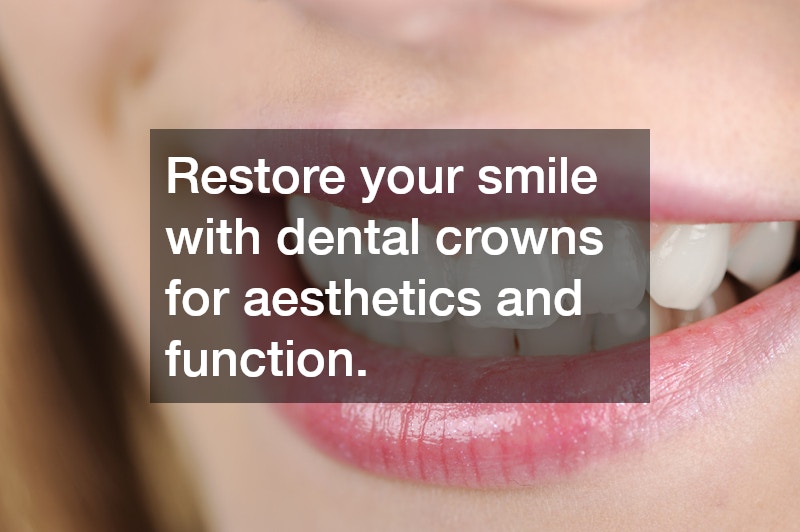
Dental crowns are among the most versatile and widely used restorative treatments in dentistry. They protect, strengthen, and improve the appearance of damaged or weakened teeth, making them an essential option for many patients. Whether someone has experienced tooth decay, a fracture, or simply wants to enhance their smile, dental crowns can provide long-lasting benefits.
For individuals seeking high-quality dental care in New York, NY, understanding the process, materials, and long-term expectations of dental crowns can help them make informed decisions about their oral health.
What Are Dental Crowns?
Definition and Purpose
A dental crown is a custom-made cap that fits over a tooth to restore its shape, size, strength, and aesthetic appearance. Dentists use crowns when a tooth is too damaged for a simple filling but still healthy enough to save. The crown completely covers the visible portion of the tooth above the gumline, providing stability and protection. Crowns also play a role in cosmetic dentistry, helping to improve the look of misshapen, discolored, or worn teeth.
Types of Dental Crowns
Different types of crowns are available depending on the patient’s needs and the dentist’s recommendation. Traditional full-coverage crowns are the most common and completely encapsulate the tooth. Partial crowns, sometimes called onlays, cover only the damaged portion while preserving healthy tooth structure. In New York, NY, many patients also choose same-day crowns made with CAD/CAM technology, which allows dentists to design and place a permanent crown in a single visit.
Materials Used
Dental crowns can be made from several durable materials. Porcelain and ceramic crowns are popular because they resemble natural teeth and blend seamlessly with existing enamel. Metal crowns—often gold or other metal alloys—offer exceptional strength, especially for molars that endure heavy chewing pressures. Porcelain-fused-to-metal crowns combine aesthetics with durability, while newer zirconia crowns provide both strength and a natural appearance. Each material has unique qualities, and the best choice depends on factors like the tooth’s location, patient preferences, and budget.
Pros and Cons
Like any dental treatment, crowns offer advantages and potential drawbacks. Their primary benefits include improved tooth strength, enhanced appearance, and long-term protection against further decay or damage. Crowns also restore the ability to chew comfortably and maintain proper bite alignment. On the downside, the process requires reshaping the natural tooth, which is irreversible. Some materials, such as all-porcelain crowns, may chip over time, while metal crowns can be more noticeable in the mouth. Patients should consider these factors and discuss them with their dentist to determine the most suitable option.
Who Needs a Dental Crown?
Dental crowns are recommended for several situations. Individuals with large cavities that cannot be repaired with a filling often need a crown to restore stability. Cracked or fractured teeth benefit from the reinforcement a crown provides. After root canal treatment, crowns are typically placed to protect the weakened tooth from breaking. Patients in New York, NY, who want to correct cosmetic imperfections such as severe discoloration or irregular shapes may also choose crowns for aesthetic enhancement. Ultimately, anyone with a compromised tooth that needs strength, protection, or cosmetic improvement may be a good candidate.
How Are Dental Crowns Installed?
Initial Consultation
The process begins with a comprehensive consultation. During this visit, the dentist evaluates the tooth, discusses the patient’s symptoms and goals, and determines whether a crown is the best solution. X-rays are usually taken to assess the tooth’s roots and surrounding bone. Patients in New York, NY may also discuss material choices and the expected timeline for treatment during this appointment.
Preparing the Tooth
Before placing a crown, the dentist must prepare the tooth by removing decay and shaping it so the crown can fit properly. This step ensures that the final restoration will be secure and comfortable. If a large portion of the tooth is missing, the dentist may build up the tooth with filling material to provide a solid foundation. Local anesthesia is used during this part of the process to ensure a painless experience.
Temporary Crowns
After the tooth is prepared, an impression or digital scan is taken to create the permanent crown. While the final restoration is being fabricated in a dental lab—or designed in-office for same-day crowns—a temporary crown is placed. This temporary crown protects the tooth, maintains function, and prevents sensitivity. It is not as durable as the final crown, so patients are often advised to avoid sticky or hard foods until the permanent crown is ready.
Fitting the Permanent Crown
Once the permanent crown is finished, the dentist removes the temporary crown and checks the fit, color, and shape of the new restoration. Adjustments may be made to ensure the bite feels natural and comfortable. When everything looks and feels right, the crown is cemented securely into place. The process is usually smooth and efficient, and many patients in New York, NY are able to return to normal eating that same day.
Post-Installation Care
Caring for a crown is very similar to caring for a natural tooth. Patients should brush twice a day, floss daily, and visit the dentist regularly for cleanings and checkups. Although crowns are durable, the gumline surrounding them still requires attention to prevent decay or gum disease. Avoiding habits like chewing on ice or grinding teeth can also help prolong the life of the restoration.
How Long Do Dental Crowns Last?
Factors Affecting Longevity
The lifespan of a dental crown varies from patient to patient. Oral hygiene habits, diet, and overall dental health all play important roles. Patients who grind their teeth, frequently chew hard foods, or neglect routine cleanings may experience crown failure sooner than those who follow proper care guidelines.
Materials and Durability
Different materials offer different levels of durability. All-metal crowns typically last the longest due to their exceptional strength. Porcelain and ceramic crowns provide excellent aesthetics but may be more susceptible to chipping. Zirconia crowns often offer a balanced combination of visual appeal and resilience, making them a popular choice in New York, NY, dental practices.
Signs of Wear and Tear
Over time, crowns may show signs of wear. Patients might notice small chips, rough edges, or discomfort when biting. Gum recession can also reveal the margin of the crown, making replacement necessary for both functional and cosmetic reasons. Sensitivity or recurring pain may indicate underlying issues that should be evaluated promptly.
When to Replace a Crown
Most crowns last between 10 and 15 years, though some can last significantly longer with excellent care. Replacement becomes necessary when the crown becomes loose, damaged, or no longer fits properly. Dentists will examine the crown during routine visits and recommend replacement when needed.
Extending the Lifespan
Patients can extend the life of their dental crowns by maintaining consistent oral hygiene, avoiding damaging habits, and scheduling regular dental checkups. Wearing a nightguard, for example, can protect crowns from grinding-related stress. With proper care, it is entirely possible for crowns to last decades.
Conclusion
Dental crowns play an essential role in restoring and protecting damaged teeth, improving both function and appearance. By understanding the materials used, the installation process, and the factors that affect longevity, patients can make informed choices about their dental care. For individuals seeking treatment in New York, NY, selecting a skilled and experienced dental provider ensures a successful outcome and a long-lasting restoration. With the right care and the right dentist, dental crowns can significantly enhance overall oral health and confidence for many years to come.



